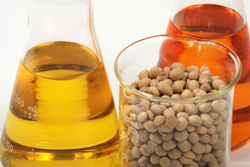New enzymes boost ethanol production
Ethanol is a by-product of the fermentation of simple sugars derived from lignocellulosic biomass. As carbon is absorbed from the atmosphere during the cultivation of the biomass, ethanol is considered a carbon neutral fuel. Aiming to promote the production and adoption of ethanol as an alternative fuel, the Energy, Environment and Sustainable Development Programme supported the TIME project. One of the targets of the ambitious work programme was to improve hydrolysis with special enzymes. The research was headed by scientists based in Finland with Roal Oy. Attention was focused on a fungus called Trichoderma reesei (T. reesei) which produces enzymes, specifically cellulases, that break down cellulose into simple sugars. Genetic engineering, namely the cloning, sequencing and transfer of 13 different genes to T. reesei, was employed in an effort to impart increased thermostability. This enables hydrolysis to take place at higher temperatures, where it is more efficient. Cellulose binding domains (CBDs) were also incorporated where necessary. Laboratory tests with synthetic substrates and Avicel cellulose were carried out to determine specific activities. In comparison with the current high performance benchmark, T. reesei CBHI (cellobiohydrolase I), the new enzymes proved not only more effective but also less susceptible to cellobiose inhibition. Another important milestone reached during the TIME project was the successful production of the novel thermophilic cellulases at pilot scale. Roal Oy managed to evaluate a range of raw materials as well as the influence of various production conditions.







